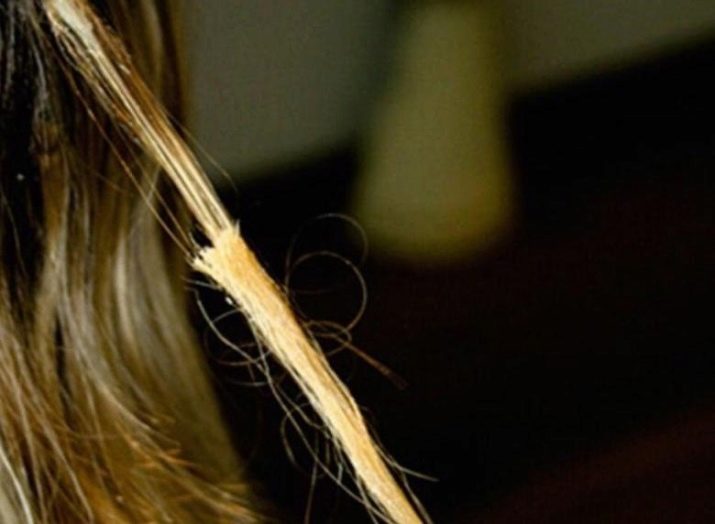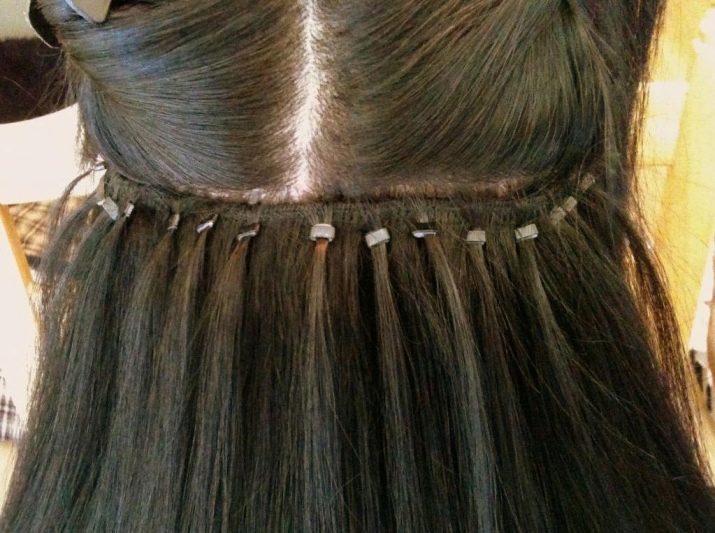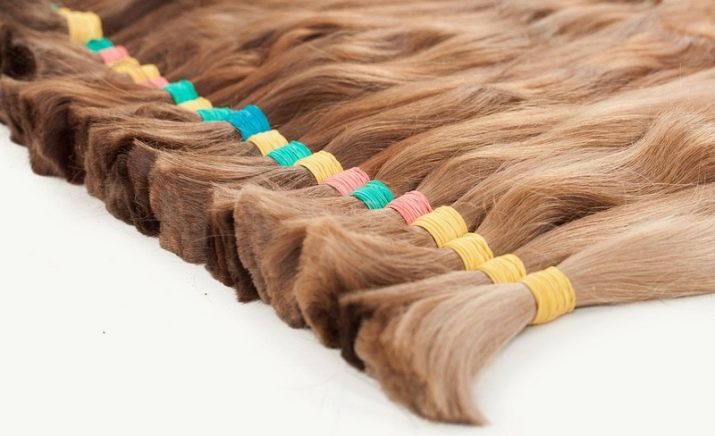Italian technology has long been one of the most popular hair extension procedures. The demand for the technique is associated with the created effect - hair extensions do not practically differ from native ones, and the technique itself is considered the most sparing for curls.

The essence of the technique
The Italian building was invented back in 1991 by the famous stylist David Gold. His clients often complained that soon after the extension according to the English method (using resinous capsules), artificial curls very poorly held on their native hair. At that moment, the hairdresser came up with the idea to come up with a special adhesive that would allow women to forget about the problems. Gold experimentally developed a special composition based on hardened keratin protein, it very firmly fixed all donor strands and reduced their loss to scratch when combed.

Extension according to the Italian technique refers to the hot methods, since in the process they use special forceps to heat capsules with keratin, however, women can be completely calm - despite exposure to elevated temperatures, the hair remains healthy and intact.
Keratin in its structure is similar to a natural protein and does not harm curls, and the capsules are very strong and comfortable to wear. Modern technologies make it possible to paint them in a wide variety of colors, so the place of transition from natural strands to extended remains invisible to prying eyes.

Advantages and disadvantages
Italian building has quite significant advantages:
- effective increase in the size of the locks and the degree of their density;
- complete safety of the whole procedure and a feeling of comfort during manipulations;
- depending on the structure of native hair, you can choose capsules of various colors, as well as volume and shape;

- places of hair fixation are completely invisible;
- keratin capsules are flexible but durable;
- the composition is hypoallergenic;
- extended locks are easy to remove;

- during the correction, the same materials are used;
- You can freely visit the pool, bathhouse, beach;
- when attaching multi-colored strands, it is possible to achieve a fashionable highlighting effect without the need to color the strands, in addition, the technique allows for all styling options.

However, there were some cons:
- the extension procedure is very time-consuming and time-consuming;
- Italian building requires a master of high qualification, any inexperienced hairdresser can not cope with all the intricacies of this work;

- in the first days after building women may feel some discomfort;
- it is impossible to comb out the hair from the capsules, so over time they will fall out.
In general, all the disadvantages are completely outweighed by the advantages of the technique. Subject to all the rules of work, donor curls do not cause their owners any discomfort, and relatives remain healthy and strong for a long time.

It should be borne in mind that the technique is not suitable for everyone. So, building is not recommended in the presence of one of the following diseases:
- atopic dermatitis;
- seborrhea;
- ringworm;
- vegetovascular dystonia.

You can not grow hair during the course of radiation and chemotherapy, as well as while taking antibiotics, in addition, you should not resort to the procedure if your native hair is too badly damaged or falls out too much.
Girls under the age of 15 do not have keratin extensions, because hair at this age is still quite weak and the procedure can severely damage them. Only a cold technique is allowed here.

Preparation
If you are determined to increase the length of your hair, do not rush to the hairdresser right away. Experts recommend first treating your own curls, especially if their condition is poor. Masters should choose a qualified, best of all, according to reviews of friends. Be sure to consult with him on all the intricacies of the procedure, since each hairdresser gives recommendations based on personal experience and skill level.
Before starting the procedure, be sure to rinse your head, since the capsule is glued only to cleaned hair.

Special attention should be paid to the selection of strands. Italian technology involves certain restrictions on the length of curls: the smallest size of donor strands is 6 cm, and the maximum can be increased to 70 cm. In order to make the hair more voluminous, it takes about 50-60 locks on average, and if you intend to achieve a significant increase in density , then up to 150-200 strands may be required - all these details should be discussed in advance with the master, since they significantly affect the final cost of the work.

Varieties of curls
The quality of the donor strands themselves deserves special attention, usually used Asian, Slavic, as well as South Russian and European.
- Asian hair are considered the most dense and direct, while their cost is minimal. At first, the hair looks smooth and luxurious, however, this effect is achieved with the help of a special wax, which loses its glossy effect as it is washed off and the hair quickly becomes unkempt and faded.

- European hair characterized by a characteristic natural shine, softness and exceptional flexibility in styling. The cut, as a rule, is even, so the hair transfers up to 3-4 corrections without damage to its appearance and structure.

- South Russian locks much more expensive than European and Asian, so they can be found infrequently in the market. Their advantage is a wide color palette, which includes an abundance of shades from light to dark blond. With proper care withstand up to 3 adjustments.

- Slavic hair - These are strands of the highest quality, respectively, and the price tag on them is high. Such curls go through a fairly strict selection before entering a beauty salon. The strands are distinguished by a perfectly even cut, all hair rods are smooth, and the curls themselves are obedient and very tender. These strands can withstand more than 4 corrections.

Technology
The procedure of Italian building is carried out in several stages, we will give a description of them.
- To begin with, the entire pile should be raised and fixed with a hair clip, while part of the hair must be left intact.
- Then the master takes the locks one by one. Traditionally, the thickness of the bundle is 2-2.5 times thinner than the volume of donor hair. A tread is put on the lock, it is intended to protect the skin from hot tongs and the ingress of the active substance on the skin.

- Donor hair is added to natural locks, for this, heated tongs are brought to the capsule for literally a couple of seconds, this time is enough for keratin to melt.

- Immediately after this, the donor curl is bonded with the natural one at a distance of several centimeters from the roots, and keratin begins to envelop both bundles and fix them firmly in the form of a capsule. The final coupling is made either with forceps or fingers - they are pressed to the capsule. If it turns out not strong enough, then it is warmed up again and re-fixed with forceps.

The growth according to the Italian method may vary depending on the size of the capsules themselves - if they are too thin, then this method is called "microcapsule building." This option is optimal for hair extensions at the parting, on short hair, on the temples and bangs.

Care
If the capsule building procedure was carried out correctly, then after 2-3 months you will need correction, sometimes the need arises later - it depends on the growth rate of native curls and their structure.
If you do not conduct timely correction, then brittle hair will appear.

Correction of Italian extensions is absolutely harmless to native hair and does not destroy their structure, which is why re-fixation can be carried out immediately after removing the capsules. In order to remove keratin crystals, the master first applies a special solvent to them, which softens the capsules and makes them supple. After that, they are broken with forceps, which visually resemble pliers, and the extended locks are gently pulled down, holding the relatives at the roots with their hands.
Then the hair is thoroughly combed, washed with shampoos, treated with care products, after which they again acquire an aesthetic appearance and can be reused. As a result, significant savings are achieved, which always pleases women.

Hair care has a few more subtleties.
- Immediately after the procedure, the curls should not be rubbed and pulled by hands - the capsules need time to harden, otherwise they simply disappear.
- Hair should be washed with water no more than twice a week, be sure to use gentle shampoos without silicones and sulfates, otherwise the curls will look heavy and unnatural. If you intend to use masks and conditioners, then they should not fall on the roots near which the capsules are located.

- The Italian extension can withstand staining, but it will still be better if you color the curls before the procedure, since hydroperit can violate the integrity of the capsule. If you have a need to dye your hair after building, make sure that the coloring composition contains no more than 6% ammonia.
- You need to brush your hair with special brushes that are sold only in specialized stores, as a rule, they have two-stage teeth (silicone and soft natural).

If you neglect these recommendations, the type of hair extensions will deteriorate quite quickly, the grip will weaken, and as a result, you will not be able to achieve the ideal effect you were counting on.
See how to make hair extensions in the next video.










